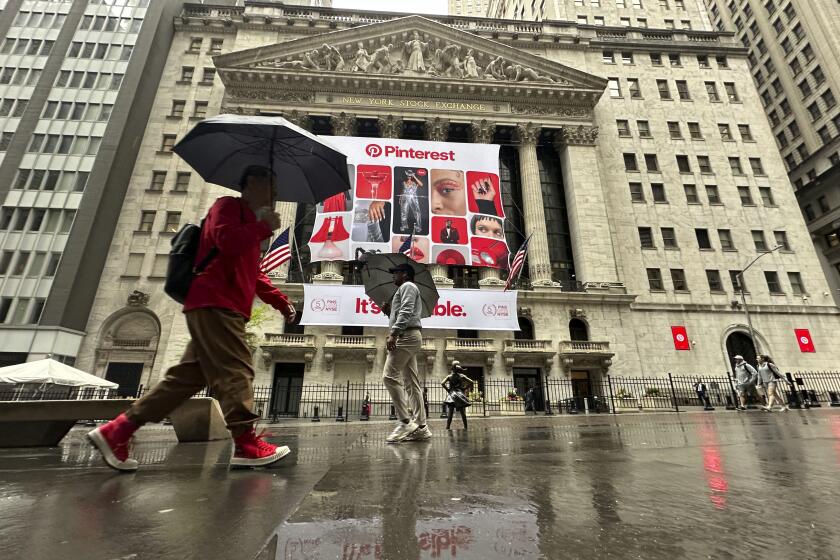Restaurant of the Stars to Close Its Doors in March
Spago Hollywood, the restaurant of the stars where entertainment careers soared and crashed over California fare prepared by chef Wolfgang Puck, will close its doors March 31, eclipsed by the newer Spago Beverly Hills and the loss of its celebrity clientele.
The success of Spago made Puck, who opened the 180-seat restaurant in 1982 on the Sunset Strip, a star in his own right. The restaurant quickly became the favorite of Hollywood’s elite, making it nearly impossible to get a seat unless you carried an Oscar or a Grammy in your back pocket.
“It was the place that everyone from out of town wanted me to take them to--whether or not they were in the business,” said Paramount Pictures Chairwoman Sherry Lansing. “I used to see Billy Wilder there all the time. And, of course, Swifty’s [Lazar] Oscar party was the only party in town then. The night Jodie Foster won the Oscar for “The Accused,” I remember the electricity in the room.”
Yet after nearly two decades of success during which Spago became one of America’s most famous restaurants, Puck and partner Barbara Lazaroff decided to close the restaurant when its lease expires.
By Hollywood standards, Spago had a long run of success. Lately, however, it had become more of a tourist hangout than a celebrity haunt.
Puck and Lazaroff were traveling Friday and were unavailable to comment, but they said in a prepared statement that the building required a costly renovation and that they would rather focus their efforts on their other business ventures.
The company would have to spend $1.5 million to $2 million to bring the restaurant--actually a house built in the 1920s--to contemporary standards, said Tom Kaplan, senior managing partner of Spago Restaurants.
Changing tastes also played a factor in the closure.
Jannis Swerman, spokeswoman for Puck, said that the Beverly Hills restaurant is more formal both in style and service. It features more of a French menu with Asian influences and the tastes of Puck’s native Austria. The Hollywood restaurant’s bistro fare leaned to a fusion of European and Asian combined with California-grown and -raised ingredients.
The pricing also is different. The average check per dinner at the Hollywood restaurant runs about $45 compared with $70 at the Beverly Hills Spago, according to Kaplan.
The original Spago menu was a reflection of the California Cuisine movement that Puck and other top chefs pioneered in the early 1980s, said Howard Gordon, senior vice president of Cheesecake Factory, the Calabasas Hills-based dining chain.
“Puck has set the tone for a lot of chefs in this area,” Gordon said. “He has done a lot of training, and people who work for him go out and start their own restaurants.”
Gordon, however, was not surprised to hear that the Hollywood restaurant will close.
“There can only be one Spago,” Gordon said. “That’s the way it is when you have a world-famous restaurant.”
Janet Lowder, a Los Angeles restaurant industry consultant, said the closure of the original Spago was made inevitable in the very way Puck marketed the newer restaurant, which opened in mid-1997.
“He gave customers the impression that the new restaurant was his showcase, the new place to be,” Lowder said. “All that was left in Hollywood was the nostalgia.”
Puck’s empire has swelled to include 42 restaurant locations, a successful soup line, frozen food business, branded cookware and cutlery, and a program on FoodTV. Last week, he cut a deal estimated at $20 million that will allow ConAgra Foods, the nation’s second-largest food company, to put his name on frozen entrees, side dishes and pizzas. A new Puck restaurant, Avalon Cove, opens next month inside Disney’s California Adventure theme park in Anaheim.
But even with plenty of Puck food offerings and eateries, long-time customers will still remember the Hollywood restaurant.
“It’s hard to believe that funny little place changed the way America eats, odd that it became the ultimate stars’ commissary,” said Robin Leach, who recalled dining there one evening with Joan Collins when Puck emerged with a “Lifestyles of the Rich and Famous” pizza: topped with salmon and caviar, served with champagne.
“I was there the very first night. I think that the restaurant, in the first 90 days, was in very serious danger of making it or not making it. There was no restaurant business in Los Angeles,” Leach said.
*
Times staff writers Claudia Eller, Jeff Leeds and Melinda Fulmer contributed to this report.







